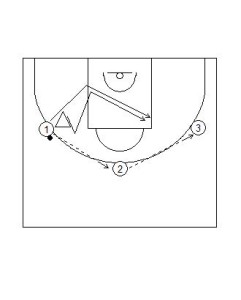Wing to Post Deny the Pass Drill
The Wing to Post Deny the Pass Drill is an activity used to help players deny perimeter to post cuts by an offense. Good ball rotation is a common way offenses use to gain space and good postposition. The Wing to Post Deny the Pass Drill looks to provide an opportunity for defensive players to practice denying this type of positioning from occurring, or at the very least resulting in an easy passing opportunity. Because of the starting position for the drill, being on the perimeter before moving to the post the defence will have an opportunity to deny the pass in two very different situations making the Wing to Post Deny the Pass Drill more effective and efficient with the use of time or repetitions during a training session.
It is a common problem for defensive players once successfully defending a V-Cut by an offensive player to allow an open cut across their face into a postposition. The Wing to Post Deny the Pass Drill looks to build the defensive awareness of the defender by ensuring they must not only separate from their defensive assignment to assume the correct help position on ball movement around the perimeter. But also be very active in closing this gap and bumping the flash cut by the offensive player in an attempt to reach the post position.
There are two options available to the defender:
- Jockeying the offensive player low and under from the high post
- Bumping the cut of the player high and over from the high post
Either technique can be suitable in denying the pass into the intend postposition.
A common problem with the Wing to Post Deny the Pass Drill is that the offensive player will become robotic in their movements towards the high post. Offensive players should be strongly encouraged once initial competence is achieved by the defence to start to change their patterns of movement in trying to reach the high post. This will ensure the most realistic outcome for the offense and defence respectively.

The Wing to Post Deny the Pass Drill starts with One (1) passing the ball to Two (2). On the flight of the ball, the defender will move from a channelling the ball into the long corner stance to denying the pass back to One (1) with a closed stance and one hand in the passing lane.
One (1) then drags defence low with an initial movement similar to a V-Cut. This position will be the eventual start of the flash cut to the strong side high post.
As One (1) reaches the double block, the defender jumps to ball and moves into an open stance. One hand pointing to One (1) and the other to the ball handler (Two).
Two (2) passes ball to Three (3). As this happens the defender should start to flatten out the so vision can be maintained between the ball and their defensive match-up.
As the flash cut begins by One (1) so too the passing lane changes, forcing the defender to adjust. The defence opens and looks to make contact with One (1) before the offensive player breaks the split line; the defence bumps and denies ball to cutter once contact is initiated.
If offence receives pass then 1 v 1 situation starts.
If the defence steals the ball, players rotate positions.
Rule:
- Do not allow back cut
The Wing to Post Deny the Pass Drill looks to build upon some specific ball denial skills in consecutive situations. The defence is often well trained to deny the initial offensive threat, but then relaxes only to allow a new opportunity to take hold. The Wing to Post Deny the Pass Drill looks to promote good defensive positioning from the perimeter to the interior and from one side of the floor to the other.







Leave a Reply